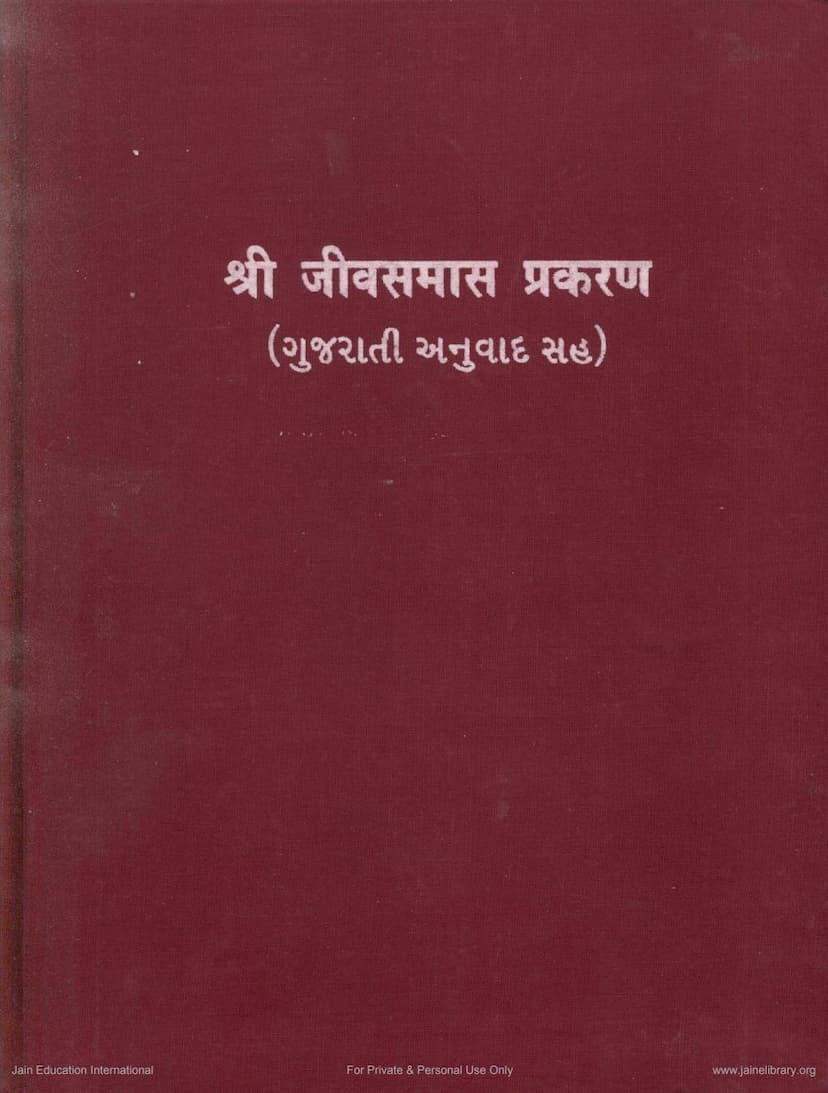Jivsamasprakaran
Added to library: September 2, 2025

Summary
The provided Jain text, "Jivsamasprakaran" by Shilchandrasuri, is a foundational work in Jain philosophy that delves into the classification and understanding of souls (Jivas). This comprehensive summary covers the key aspects presented in the text, based on the provided pages.
Book Title: Jivsamasprakaran Author(s): Shilchandrasuri Publisher: Jain Granth Prakashan Samiti Year of Publication: 1994
Overall Purpose and Scope: The "Jivsamasprakaran" is a treatise on the classification of souls in Jainism, aiming to provide a systematic and detailed understanding of the different types of souls (Jivas) based on various criteria. It serves as an essential text for the study of Jain metaphysics and cosmology, particularly focusing on the "Dravyānuyog" (the study of substances or realities).
Key Concepts and Structure (as inferred from the table of contents and introductory sections):
The text appears to follow a logical structure to enumerate and describe the various classifications of souls. Based on the table of contents (Page 15-21), the book systematically explores:
- Nirūpaṇa (Description/Classification): The core of the text likely lies in the detailed exposition of different soul classifications.
- Mārgaṇasthānas (Modes of Investigation/Classification Criteria): The text employs numerous criteria or "mārgaṇas" to categorize souls. These include:
- Gati (States of Existence): 4 types (Hellish beings, Tiryanch, Human, Heavenly beings).
- Indriya (Senses): 1-sensed to 5-sensed beings.
- Kāya (Body Types): 6 types (Earth-bodied, Water-bodied, Fire-bodied, Air-bodied, Plant-bodied, and Trasa-bodied beings).
- Yoga (Activities): Mental, verbal, and physical activities.
- Veda (Feelings/Desires): Masculine, Feminine, and Neuter feelings.
- Kashaya (Passions): Anger, Pride, Deceit, and Greed.
- Jñāna (Knowledge): 5 types of knowledge (Mati, Śruta, Avadhi, Manahparyaya, Kevala).
- Samyama (Restraint): Various levels of restraint and conduct.
- Darśana (Perception): 4 types of perception.
- Leshya (Subtle Karmic Dispositions): 6 types (Krishna, Neel, Kapot, Tejas, Padma, Shukla).
- Bhavya (Potential for Liberation): Souls capable of liberation.
- Samyaṅtva (Right Faith): Various stages of right faith.
- Saṅjñi (Consciousness/Discrimination): Beings with and without proper consciousness.
- Āhāra (Nourishment): Souls that take nourishment and those that do not.
- Naya (Standpoints): The text likely utilizes different philosophical standpoints (Nayas) to explain the classifications.
- Pramāṇa (Measures/Quantification): A significant portion of the text is dedicated to quantifying various aspects of Jivas, including:
- Dravya-pramāṇa (Substance Measure): Discussing the quantity of substances.
- Kṣetra-pramāṇa (Spatial Measure): Measuring the extent or area occupied by Jivas.
- Kāla-pramāṇa (Temporal Measure): Measuring the duration of existence and states.
- Bhāva-pramāṇa (Qualitative Measure): Measuring the intensity or quality of states.
- Specific Classifications: The text details various classifications within each category, such as:
- Narakas (Hellish Beings): Their existence, states, and lifespan across different hellish realms.
- Devas (Heavenly Beings): Different classes of heavenly beings (Bhavanapati, Vyantaras, Jyotishis, Vaimānikas) and their characteristics.
- Tiryanch (Sub-human Beings): Including the detailed descriptions of geographical realms (Dvipas and Samudras), the unique characteristics of beings in Jambudvipa (e.g., Yuǵalikas), and the various forms of Tiryanchs.
- One-sensed Beings (Ekendriyas): Elaborate descriptions of Earth-bodied, Water-bodied, Fire-bodied, Air-bodied, and Plant-bodied beings, including their different forms and states.
- Two-sensed to Five-sensed Beings: Classification based on the number of senses.
- Detailed Analysis of Measures: The latter part of the table of contents suggests a deep dive into various measures like Angulas, Yojanas, Palya, Sāgaropama, and their interrelationships.
The Text's Approach:
- Commentary (Ṭikā): The publication includes a detailed commentary by Māldhārī Śrī Hemchandrasuri, which is crucial for understanding the original text's nuances. The translation and editing by Pandit Late Shah Chandulal Nanchand Shinorwala and Pandit Shīlchandra Vijay Gani, respectively, aim to make this complex text accessible.
- Origin: The text is described as originating from the "Satya Pravāda Pūrva," the sixth Pūrva within the twelfth Anga of the Dvādaśāṅgī, highlighting its ancient roots and scriptural authority.
- Focus on Spiritual Knowledge: The editorial notes emphasize the importance of Śrutajñāna (scriptural knowledge) and Dhyāna (meditation) for spiritual progress, suggesting the practical application of the text's philosophical insights.
- Authorial Humility: The text notes that many great souls composed scriptures without seeking personal recognition, highlighting a significant aspect of spiritual detachment and devotion to the divine.
Significance:
The "Jivsamasprakaran" is a vital text for understanding the Jain perspective on the nature of existence, the soul, and the various conditions it can experience. Its detailed classification system, based on empirical observation and rigorous philosophical analysis, provides a comprehensive framework for spiritual practitioners to grasp the complexities of the soul's journey through the cycle of birth and death (Saṃsāra).
In essence, the "Jivsamasprakaran" is a scholarly and detailed exploration of the Jain ontology, meticulously classifying and quantifying every known aspect of the soul's existence, aimed at providing profound knowledge for spiritual liberation.